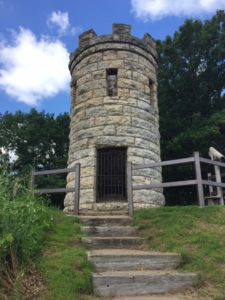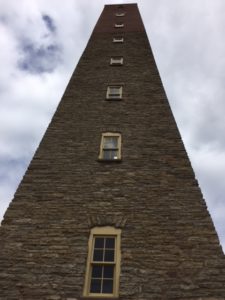One of the things I love about the RV life and traveling is the way it breaks my own stereotypes and preconceived notions about a place. I mentioned this in my visit to Texas. I expected one stereotypical thing, but found a much richer, fuller, more nuanced place. Texas, it turns out, isn’t all cowboys and BBQ. The same thing happened in Dubuque, Iowa. I thought cornfields and farmers. But found so much more.
For starters, Dubuque is on the Mississippi River. Who knew? Well, a lot of people probably knew. But not me. Even though I knew the Mississippi River traveled the vertical length of the US, I somehow still thought of it as a southern river. Probably because of the name.
I looked this up. Did you know the Mississippi River (2nd largest in the US after the Missouri River) travels through or along 10 different US states? Can you name them? I’ll let you think about it and post the answer at the bottom.
The Mississippi River towns are comely, clean, well built, and pleasing to the eye, and cheering to the spirit.
Mark Twain in his book Life on the Mississippi
A Little History
Iowa became the 29th state in the last days of 1846 under James K. Polk. Isn’t it astounding how much of my travel finds ways to tie together? In the spring I visited James K. Polk’s house in Columbia, Tennessee. Dubuque was officially founded 13 years before statehood.
But the first permanent settler in Dubuque—and in all of Iowa, in fact—came long before that. Upon his arrival, French-Canadian fur trader named Julien Dubuque befriended the Mesquakie Tribe. The Mesquakie gave him rights to the land in 1788 to work the lead mines. The Spanish governor (because France ceded the area to Spain in 1762) confirmed land rights to more than 70,000 acres in 1796.
It stretched 11 miles north and south of Catfish Creek and nine miles west. The area shown on early 18th century maps as “mine de plomb” which means Lead Mines became known as Mines of Spain.
Dubuque forged a strong relationship with the tribe, even, according to legend as no records exist, marrying Potosa, daughter of Chief Peosta. Dubuque died in 1810 at age 48 and the Mesquakie buried him with tribal honors on a bluff overlooking the Mississippi River at the mouth of Catfish Creek and the Mines of Spain. In 1897, the Old Settlers Association erected a 25-foot tall limestone monument over the grave. It stands today and Chief Peosta is buried nearby.
My month in Dubuque covered a couple weeks in each of June and July. It was hot and humid. Too hot and humid for this Alaskan and too hot and humid for this Alaskan’s pup.
I said this in the Northern Alabama post as well. The heat, unfortunately, prevented me from going on some of the adventures I was looking forward to. That’s okay because it just means I must return.
I adore natural walks, nature centers, interpretive trails, walking paths, etc. and there were quite a few to choose from in the area. I only made it to three: Mines of Spain and the Julien Dubuque Monument, Dubuque Botanical Gardens and the Mississippi River Walk.
Mines of Spain and the Julien Dubuque Monument
The Mines of Spain is a State Recreation Area with 11 different hiking trails and a pretty driving loop that takes you to the different trails. I started by visiting the EB Lyons Interpretive Center. But because I had Solstice with me, I did only a cursory walk through. Even parked in the shade at 9 a.m., I didn’t feel comfortable leaving her in the van for too long.
Even though I knew we were going to be sweating the entire time, I was determined to do at least one trail. I chose the easiest and the shortest. The feature photo is from the walk. Solstice and I walked the American State Tree Woodland Walk. At just over half a mile round-trip, the trail is disabled-friendly with a wide paved, mostly flat, path.
Along the path are trees, though they are a ways back so don’t offer any shade. What makes them noteworthy is that each tree comes from each of the 50 different US states. I thought that was a unique idea. Not something I’d seen before.
At the top of the path we found an area to sit and enjoy the view because the slight incline put us up a bit. In the cement is a big compass, pointing north, south, east and west.
The north, east and west letters were perfect. And I wanted a picture of south. Wouldn’t you know it? The top of the S was broken. But S is for Solstice so that’s the picture we took.
With the air conditioner van on high, we then drove the loop to experience the 1,400 acres area from the comfort of cool air. We stopped and walked the short path to the Julien Dubuque Monument.
It was well worth getting hot again.
Botanical Gardens
Interestingly, Botanical Gardens have been on my general “to see” list but the Dubuque Botanical Gardens were the first I made it to. What a great “first.”
The Dubuque Botanical Gardens are actually inside a larger park called the Dubuque Arboretum, so even the drive to the gardens is beautiful and green with trees, paths, play areas and benches.
Admission is zero dollars. Though, as a nonprofit, they accept donations. I learned from other travelers that free botanical gardens are a rarity. I don’t know if this is true at other botanical gardens or not but the Dubuque Gardens are open a couple hours before the Visitors Center.
The fact that I could walk the gardens at 7 a.m. is the only reason I saw them. If I had to wait until 9, it simply would’ve been too hot. Actually, it was already pretty darn hot. When I finished walking around, I went into the gift shop and the volunteer exclaimed, “You are steaming.” She couldn’t have said it better because that’s exactly how I felt.

One of the many garden paths. I took the photo from the second floor balcony of the Visitors Center.
The gardens were just beautiful and green and lush. There was a Rose Garden, a Japanese Garden, an English Garden and others. It seemed like a large facility but having nothing to compare it to, I cannot say for sure.
Considering how hot I was, you might think my favorite garden was the Shade Garden. But you’d be wrong. Surprising to me was the fact that my favorite garden wasn’t a flower garden at all.
My favorite was the Herb Garden.
For the most part, the Herb Garden consists of green bushy plants, not the pretty flowers. For reasons I cannot really explain, the Herb Garden touched me. I sniffed many of the herbs. Touched the leaves and smelled my fingers of the ones too low to the ground for my nose to reach.
I thought about cooking…how could you not? And all the ways I would use this herb or that one. I was intrigued by the herbs I’d never heard of. The garden included herbs used for teas as well. Had it not been for the heat, I would’ve sat in the Herb Garden absorbing the loveliness and calming energy.
After touring the Botanical Gardens, I told every Dubuque resident (Dubuquian? Dubuquite?) that if I lived in Dubuque, I would go to the Botanical Gardens once a week and that they should too. It’s a free treasure to the community. The only tiny downside is that dogs aren’t allowed. That’s true for both the Botanical Gardens and the Arboretum. But, of course, it’s easy to understand why.
Mississippi River Walk
If you go in the summer, the Mississippi River Walk includes a bonus. Art. Since 2006, artists have displayed sculptures along the walk and it’s referred to as Art on the River. They are for sell. Ten were installed in 2018, but by the time I walked only eight remained. I assumed that meant the other two sold.
I believe each year has a theme. But I’m unsure how artists are selected. Invitation? Or through an application process? I admit, I don’t know those details. I just know how much I enjoyed the art walk.
So much, in fact, I went back three times. The River Walk is popular. At lunchtime, locals exercised on the wide walkway. With the River Walk just out the backdoor of the Convention Center and a couple blocks from the big National Mississippi River Museum and Aquarium, it is a poplar place.
I like many of the pieces but my favorite was the giant gas can, called Juice Box. The artist has a sense of humor.
Shot Tower
The Shot Tower stands over 120 feet tall (the equivalent of seven stories) but is not open to go inside. And if you don’t know what you’re looking at, you probably wouldn’t give the building a second thought but when you read the placard and understand what a shot tower is and how it works, you see the long skinny building with new eyes. And you think, “That’s one cool building.”
A shot tower, also referred to as a drop tower, is where lead balls (for rifles) were once made. The process, invented by an Englishman in the 1760s, for creating the lead balls is pretty simple. From the top of the tower, molten (liquid) lead is poured through a copper grate ensuring the balls are about the same size. Then the balls fall—or drop—to the bottom of the tower into the cooling tub of water.
During the fall, two things happen. First, due to surface tension, the droplets of molten lead become spheres and, second, the ball begins the cooling process which helps maintain its shape.
The Shot Tower in Dubuque operated from 1856 through 1881. At that point, it became a fire watch station until 1911 when, yep, it caught fire and gutted the building. You have to admit, the irony is funny. Since 1911, it has been maintained as a historical land mark.
Because you can’t go in, I am not sure this would make it onto people’s list of Dubuque tourist stops if not for the location. It’s a stone’s throw from the Mississippi River and just one block from one end (or the beginning, depending on how you look at it) of the Mississippi River walk.
I’m so glad for the location because I enjoyed learning about drop towers and seeing this one. Since their decline in popularity, many have been demolished. As I understand it, only a handful of towers remain in the US.
An Unexpected Surprise
Guess what? In Dubuque, I saw fireflies. For the first time. Ever.
Because I hadn’t seen them before, it took me a bit to understand the flashes of light. In my mind, fireflies lit up and stayed lit up. That’s why, at first, I didn’t know what the brief soft streaks of orange light in the night were.
Seeing fireflies. Another bucket list item. Check.
Trivia answer: The Mississippi River travels through or along: Minnesota, Wisconsin, Iowa, Illinois, Missouri, Kentucky, Tennessee, Arkansas, Mississippi and Louisiana.
I have two more installments about my time in Dubuque. First, the museums I visited. Second, the hodgepodge of other adventures including my first movie set. Those will come over the next few weeks. Stay tuned.
Links to Referenced SSL Blog Posts Above:
- Fredericksburg in Texas Hill Country
- Middle Tennessee
- Deep in the Mountain, High in the Sky: Adventures in Northern Alabama
To see products recently purchased by readers or to browse and shop at Amazon, follow either of these links. Huge thanks for your support.















Hi Debbie, I love the paragraph about seeing fireflies! We call them lightening bugs in the south????. I so remember catching them in a mason jar as a child. I also know if one hits your windshield, he stays lit up! Albeit, splattered????! Love your adventures! Enjoy!
I had heard of people catching them in jars, but never thought of them on going splat on the windshield. After I made the post I started thinking about their name and wondering if they were like regular flies. Wouldn’t it be ironic? Most of us think of house flies as dirty nasty things. Thanks for the comment, Kim.
I guessed 6 out of 10 states along the Mississippi River, Ryan guessed 7 out of 10 and to no surprise, the Eagle Scout, Toby guessed all 10! When I was taught at school about the Mississippi River and its surrounding states the nuns taught us about “The Baker”. From a side view, Minnesota is his baking hat, Iowa is his face with a nose jutting out, Missouri rounds out his pot belly, Louisiana forms his boots and the back of those states make up the back of his body. Can you see it? Ryan could, Toby couldn’t. Loved the tour and history as always. Love, Marie
Those nuns were pretty smart. I never heard of this technique, but obvious it works. All these years later you still remember it. That’s awesome. Before my visits to Tennessee and Iowa, I probably could only name 4 or 5. I’m learning so much in my travels, and so much of things I never expected I’d be interested in. It’s a treat. Glad you liked the post.